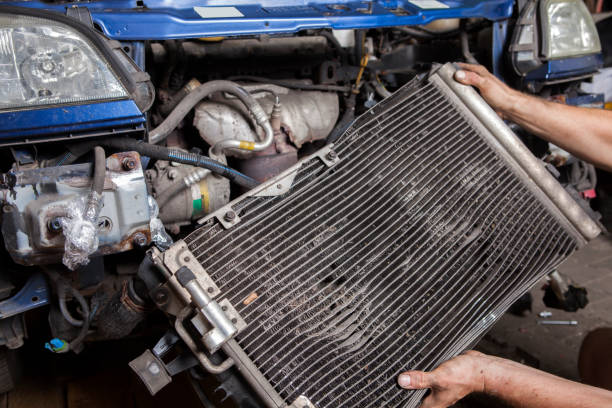No, a bad radiator typically does not directly cause a car not to start. The radiator is a component of the vehicle’s cooling system, responsible for regulating the engine’s temperature by dissipating heat from the coolant. While a malfunctioning radiator can lead to engine overheating and potential damage, it does not directly impact the starting of the engine. SuncentAuto parts and accessories are of excellent quality and also affordable in the automotive aftermarket store.
However, there are scenarios in which an overheated engine due to a bad radiator can indirectly contribute to a no-start situation:
Engine Overheating: A faulty radiator may not cool the engine properly, leading to overheating. Extreme engine temperatures can cause damage to various engine components, including the cylinder head gasket, which can lead to compression loss and potentially affect engine performance. If the engine overheats severely, it may shut down as a protective measure, and it might not restart until the issue is resolved.
No Coolant: If a radiator leak is severe enough, it can cause a loss of coolant. Low coolant levels can result in the engine overheating and eventually shutting down, which may prevent the vehicle from starting until the coolant is replenished and the radiator issue is addressed.
Other Engine Issues: It’s possible that the overheating caused by a bad radiator could exacerbate pre-existing engine issues or trigger additional problems. These issues, in turn, might affect the engine’s ability to start.
How to clean radiator of car at home?
Cleaning your car’s radiator at home can help maintain efficient cooling and prevent overheating. However, it’s essential to approach this task with caution and the right tools. Here’s a step-by-step guide on how to clean your car’s radiator at home:
Tools and Materials Needed:
Safety Gear: Wear safety goggles, gloves, and appropriate clothing to protect yourself from hot coolant and debris.
Basic Tools: You’ll need a socket wrench or pliers to remove clamps and fasteners.
Garden Hose: A garden hose with a spray nozzle will be used to flush the radiator.
Radiator Cleaner: Purchase an efficient radiator cleaning solution from an auto parts store. It’s specifically designed to break down deposits and contaminants.
Bucket: You’ll need a clean bucket to catch and dispose of the old coolant.
Funnel: A funnel helps you pour new coolant back into the radiator without spilling.
Steps to Clean Your Car’s Radiator:
- Ensure Safety:
Make sure your vehicle is completely cooled down before starting any work on the radiator. Attempting to work on a hot radiator can result in burns or injuries.
- Park on a Level Surface:
Park your car on a level surface to ensure that the radiator is evenly filled and that the vehicle is stable.
- Locate the Radiator:
Pop the hood of your car and locate the radiator. It’s typically positioned at the front of the engine compartment, directly behind the grille.
- Drain the Coolant:
Place the clean bucket under the radiator drain valve, usually located at the bottom of the radiator.
Open the drain valve and let the old coolant flow into the bucket. Dispose of the old coolant properly, as it is hazardous waste. Many auto parts stores accept used coolant for recycling.
- Remove the Radiator Cap:
Remove the radiator cap to allow air to flow freely during the cleaning process.
- Use Radiator Cleaner:
Follow the instructions on the radiator cleaner product you purchased. Typically, you’ll mix the cleaner with water as directed.
Pour the mixture into the radiator until it’s full.
- Start the Engine:
Start the car and let it idle for about 10-15 minutes with the radiator cleaner inside. This will help the cleaner circulate through the cooling system.
- Flush the System:
Turn off the engine and allow it to cool down again.
Use the garden hose with a spray nozzle to flush out the radiator. Direct the water into the top of the radiator and let it flow out of the drain valve into the bucket.
Continue flushing until the water runs clear, indicating that the radiator is clean of debris and cleaner residue.
- Refill with Coolant:
Close the drain valve and remove the bucket.
Using a funnel, pour a mixture of fresh coolant and water into the radiator until it’s full. Refer to your vehicle’s owner’s manual for the correct coolant-to-water ratio and type of coolant to use.
- Bleed the System:
Start the engine and let it run with the radiator cap off for a few minutes to bleed air from the system.
Top off the radiator with more coolant as needed.
- Replace the Radiator Cap:
Put the radiator cap back on securely.
- Check for Leaks:
Inspect the radiator and hoses for any signs of leaks.
- Dispose of Old Coolant:
Dispose of the old coolant at an appropriate recycling or disposal facility.
By following these steps carefully, you can effectively clean your car’s radiator at home and ensure it operates efficiently, keeping your engine cool and preventing overheating. If you encounter any issues or are uncomfortable performing this maintenance task, it’s advisable to seek assistance from a professional mechanic.

